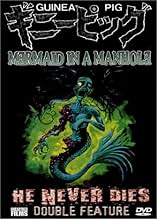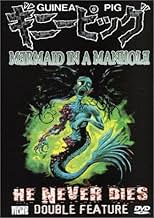Ginî piggu: Manhôru no naka no ningyo
- Video
- 1988
- 1h 3min
VALUTAZIONE IMDb
5,5/10
2677
LA TUA VALUTAZIONE
Aggiungi una trama nella tua linguaAn artist rescues a mermaid in a sewer, who develops bleeding sores all over her body. He paints a portrait with what oozes from her body, and eventually dismembers her.An artist rescues a mermaid in a sewer, who develops bleeding sores all over her body. He paints a portrait with what oozes from her body, and eventually dismembers her.An artist rescues a mermaid in a sewer, who develops bleeding sores all over her body. He paints a portrait with what oozes from her body, and eventually dismembers her.
Recensioni in evidenza
8w00f
Wow.
I have rarely seen a film that manages to be intensely disgusting and poetically beautiful at the same time. Despite the reputation of the Ginipiggu films, this wasn't the most intense gore I've ever seen... Fulci's "Paura nella città dei morti viventi" is more disturbing, if not more graphic, and certainly far more violent. Fulci's film doesn't come close to the visual poetry that "Mermaid" exhibits in places, nor does it delve into the places in the soul that this film did.
Confused yet?
The basic story of "Mermaid": a Japanese artist has a penchant for lurking in a sewer near his home. We find out that this is because a beautiful mermaid lived in the river that once flowed where the sewer now sits. While skulking in the sewer one day, he finds the mermaid. She's been living in the darkness for decades, having become stranded when the city was built. The painter visits her repeatedly, and one day notices a horrible infection beginning on her abdomen. He realizes that she's gotten this infection from being trapped in the sewer for so long, and so he takes her home to care for her and paint her.
The mermaid is the embodiment of the painter's childhood dreams, his innocence, and his joy. The infection is the decay of his own being, his psyche itself. As the film progresses, so does the infection, slowly disfiguring the mermaid until she comes to resemble ground beef covered with tumors that ooze multi-colored pus and occasionally give rise to masses of worms. She won't die, though, until he finishes his painting of her. She does die (which is an obvious outcome from the early part of the film -- but not the *ending*), and she does so slowly, painfully, horribly, and very graphically. If the thought of a boil-covered, bleeding woman lying in a bathtub filled with her own blood (and other fluids) while vomiting up blood and worms seems unpalatable to you, do NOT watch this film. I could easily see some of the scenes inducing a reversal of peristalsis in many viewers. I've seen some intense horror flicks and some very "realistic" gore, but there were definitely some nauseating and difficult moments for me in "Mermaid".
There's also a scene wherein the mermaid has died and we see flowing paint obscure the paintings that the artist has rendered from his childhood memories as he dismembers her body, ostensibly for disposal. If I told any more, though, I'd be giving away the ending... and that wouldn't be fair.
If you've got the stomach for it, I would highly recommend this film. The acting is solid (the dialogue is in Japanese with English subtitles), and the production values are quite good for a straight-to-video effort. This was a top ten seller in Japan for two months when it first came out, and with good reason. In many ways, this is a really excellent film, and it balances loathing and almost Poe-like horror with a certain inner beauty. I'm not generally a big fan of Japanese horror, but I haven't seen anything else that manages such a fine balancing act.
"Mermaid in a Manhole" is available in the US only through Unearthed Films. It's worth the effort and expense to get hold of a copy.
I have rarely seen a film that manages to be intensely disgusting and poetically beautiful at the same time. Despite the reputation of the Ginipiggu films, this wasn't the most intense gore I've ever seen... Fulci's "Paura nella città dei morti viventi" is more disturbing, if not more graphic, and certainly far more violent. Fulci's film doesn't come close to the visual poetry that "Mermaid" exhibits in places, nor does it delve into the places in the soul that this film did.
Confused yet?
The basic story of "Mermaid": a Japanese artist has a penchant for lurking in a sewer near his home. We find out that this is because a beautiful mermaid lived in the river that once flowed where the sewer now sits. While skulking in the sewer one day, he finds the mermaid. She's been living in the darkness for decades, having become stranded when the city was built. The painter visits her repeatedly, and one day notices a horrible infection beginning on her abdomen. He realizes that she's gotten this infection from being trapped in the sewer for so long, and so he takes her home to care for her and paint her.
The mermaid is the embodiment of the painter's childhood dreams, his innocence, and his joy. The infection is the decay of his own being, his psyche itself. As the film progresses, so does the infection, slowly disfiguring the mermaid until she comes to resemble ground beef covered with tumors that ooze multi-colored pus and occasionally give rise to masses of worms. She won't die, though, until he finishes his painting of her. She does die (which is an obvious outcome from the early part of the film -- but not the *ending*), and she does so slowly, painfully, horribly, and very graphically. If the thought of a boil-covered, bleeding woman lying in a bathtub filled with her own blood (and other fluids) while vomiting up blood and worms seems unpalatable to you, do NOT watch this film. I could easily see some of the scenes inducing a reversal of peristalsis in many viewers. I've seen some intense horror flicks and some very "realistic" gore, but there were definitely some nauseating and difficult moments for me in "Mermaid".
There's also a scene wherein the mermaid has died and we see flowing paint obscure the paintings that the artist has rendered from his childhood memories as he dismembers her body, ostensibly for disposal. If I told any more, though, I'd be giving away the ending... and that wouldn't be fair.
If you've got the stomach for it, I would highly recommend this film. The acting is solid (the dialogue is in Japanese with English subtitles), and the production values are quite good for a straight-to-video effort. This was a top ten seller in Japan for two months when it first came out, and with good reason. In many ways, this is a really excellent film, and it balances loathing and almost Poe-like horror with a certain inner beauty. I'm not generally a big fan of Japanese horror, but I haven't seen anything else that manages such a fine balancing act.
"Mermaid in a Manhole" is available in the US only through Unearthed Films. It's worth the effort and expense to get hold of a copy.
A painter named Hayashi(Shigeru Saiki)finds a wounded mermaid(Mari Somei)and saves her.He takes her home and puts her into his bathtub where she keeps decomposing,the spreading disease spurting blood and pus.Hideshi Hino's "Guinea Pig 4:Mermaid in the Manhole" is easily one of the most disgusting horror movies I have ever seen.The make-up effects made by Nobuaki Koga are incredibly revolting.The character of Hayashi is pretty sympathetic and the film has a mood of a very sad romance.The mermaid represents painter's wife and "all the beautiful things" he has lost,so she is bound to rot and vanish too."Mermaid in the Manhole" works as a piece of extreme art,so anyone who loves Japanese horror should give it a look.However if you're easily offended avoid this one like the plague.
Guinea Pig III: Mermaid in a Sewer (Hideshi Hino, 1988)
Mermaid in a Sewer, one of the four Guinea Pig films directed by Hino, is the only one that rivals The Flower of Flesh and Blood in notoriety and popularity. Unlike its more graphic and brutal cousin, Mermaid in a Sewer (often translated as Mermaid in a Manhole, Mermaid in the Bathtub, or any other number of similar titles) actually has a plot to it. An artist (Shigeru Saiki), obviously modeled on Hino himself (Hino's style is unmistakable), draws his inspiration from things he sees and finds in his local sewer system. One day, what he finds among the muck and stench is... a mermaid (Mari Somei). Yes, a mermaid. A very attractive one at that (and one is forced to wonder what, exactly, would motivate an actress to play a part like this...). We find out, after the two have conversed a bit and he's done a preliminary sketch, that she is wounded. He takes her home (how he gets her there without anyone noticing is beyond me) and installs her in his bathtub in order to take care of her.
You can see where this is going, I'm sure. Wound + sewer = bad, bad things.
I'd comment on the acting, dialogue, etc. if I actually understood Japanese. Sometimes watching films in foreign languages with no subtitles is good for the soul, I guess (though anyone who happens to have a script from either 2 or 3 in English who'd be willing to send a copy my way would be remembered in my will, and not with a debt). The couple who lives downstairs from the artist (Masami Hisamoto, Tsuyoshi Toshishige) pop up every now and then to give what would seem a comic turn to the film, which only adds to the disgust and horror. If you get nightmares easily, this is not a film you ever want to see. As Joaquin Phoenix said in what was one of only a handful of lines in _8mm_ that's actually worth remembering, "there are some things you can't un-see." I could never pop this tape into the cassette player again, and certain images would remain as fresh in my mind as they are right now. It's that bad. *** 1/2
Mermaid in a Sewer, one of the four Guinea Pig films directed by Hino, is the only one that rivals The Flower of Flesh and Blood in notoriety and popularity. Unlike its more graphic and brutal cousin, Mermaid in a Sewer (often translated as Mermaid in a Manhole, Mermaid in the Bathtub, or any other number of similar titles) actually has a plot to it. An artist (Shigeru Saiki), obviously modeled on Hino himself (Hino's style is unmistakable), draws his inspiration from things he sees and finds in his local sewer system. One day, what he finds among the muck and stench is... a mermaid (Mari Somei). Yes, a mermaid. A very attractive one at that (and one is forced to wonder what, exactly, would motivate an actress to play a part like this...). We find out, after the two have conversed a bit and he's done a preliminary sketch, that she is wounded. He takes her home (how he gets her there without anyone noticing is beyond me) and installs her in his bathtub in order to take care of her.
You can see where this is going, I'm sure. Wound + sewer = bad, bad things.
I'd comment on the acting, dialogue, etc. if I actually understood Japanese. Sometimes watching films in foreign languages with no subtitles is good for the soul, I guess (though anyone who happens to have a script from either 2 or 3 in English who'd be willing to send a copy my way would be remembered in my will, and not with a debt). The couple who lives downstairs from the artist (Masami Hisamoto, Tsuyoshi Toshishige) pop up every now and then to give what would seem a comic turn to the film, which only adds to the disgust and horror. If you get nightmares easily, this is not a film you ever want to see. As Joaquin Phoenix said in what was one of only a handful of lines in _8mm_ that's actually worth remembering, "there are some things you can't un-see." I could never pop this tape into the cassette player again, and certain images would remain as fresh in my mind as they are right now. It's that bad. *** 1/2
Director Hideshi Hino brings his manga to screen as an installment in the notorious GUINEA PIG series, about a recently widowered painter who finds artistic inspiration in an unlikely location from an unlikely creature. For gorehounds and ONLY gorehounds. The special effects—albeit twisted—are undeniably impressive. Probably one of the only films that could make the viewer want to run to the bathroom and vomit—not counting hand-held-styled movies that causes motion sickness. Aside from the shameless nastiness, the story's originality should also be recognized because of how difficult it can be to pull off this type of horror without involving serial killers or monsters in the mix.
*** (out of four)
*** (out of four)
I think during the 80's, while Cronenberg and the like were showing their special effects skills, some daring Japanese directors were ready to show their might on the screen and it led to these films. All of them were put together to showcase nothing more than special effects with almost no story line whatsoever. Except this little gem!! I have to say, these films are definitely heavy on the gore, and they are way good at the special effects. They definitely caught me off guard when I saw them without knowing what I was sitting down to watch. But that's where it ends, special effects for gross out factors (which the Japanese do very well). But again, this one is a bit different than the others, so don't just write it off like perhaps "Flower of Flesh and Blood" or "Devil's Experiment".
First off, this has the artist element, as the crazy man who paints the scum and filth inside of a sewer would. And it has a very strange feeling almost from the get go. An almost bizarre art house quiet despair right from the get go. You can almost smell the rotting filth just by watching it. And that's exactly how I can explain this film, as if you watch an animal get hit by a car and watch it die, and subsequently rot to a bloody mess on the side of the road. But that's only an allegory to what the movie looks like, as the movie is perhaps an allegory to a deeper meaning.
While this film is certainly vile, and has loads of gross out factors from stem to stern, it has a certain humanity to it. Almost a beautiful love to it. And that is where this movie stands out from the others.
If you've seen the others and haven't seen this one, then definitely watch it. If you've wanted to see them, and haven't yet, definitely watch this one. If you like gross out gore cinema, then definitely watch this one. If you're weak in the stomach, then steer very far away from any of these films.
First off, this has the artist element, as the crazy man who paints the scum and filth inside of a sewer would. And it has a very strange feeling almost from the get go. An almost bizarre art house quiet despair right from the get go. You can almost smell the rotting filth just by watching it. And that's exactly how I can explain this film, as if you watch an animal get hit by a car and watch it die, and subsequently rot to a bloody mess on the side of the road. But that's only an allegory to what the movie looks like, as the movie is perhaps an allegory to a deeper meaning.
While this film is certainly vile, and has loads of gross out factors from stem to stern, it has a certain humanity to it. Almost a beautiful love to it. And that is where this movie stands out from the others.
If you've seen the others and haven't seen this one, then definitely watch it. If you've wanted to see them, and haven't yet, definitely watch this one. If you like gross out gore cinema, then definitely watch this one. If you're weak in the stomach, then steer very far away from any of these films.
Lo sapevi?
- QuizThis is the last film starring Mari Somei, as the 25-years-old actress mysteriously disappeared in 1988. Her fate remains unknown.
- Curiosità sui creditiAt the end of the credits there is a small scene in the sewer where we hear something move in the water.
- ConnessioniEdited into Guinea Pig's Greatest Cuts (2005)
I più visti
Accedi per valutare e creare un elenco di titoli salvati per ottenere consigli personalizzati
Dettagli
- Data di uscita
- Paese di origine
- Lingua
- Celebre anche come
- Guinea Pig 5: Mermaid in a Manhole
- Aziende produttrici
- Vedi altri crediti dell’azienda su IMDbPro
- Tempo di esecuzione1 ora 3 minuti
- Colore
Contribuisci a questa pagina
Suggerisci una modifica o aggiungi i contenuti mancanti




















